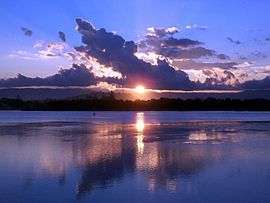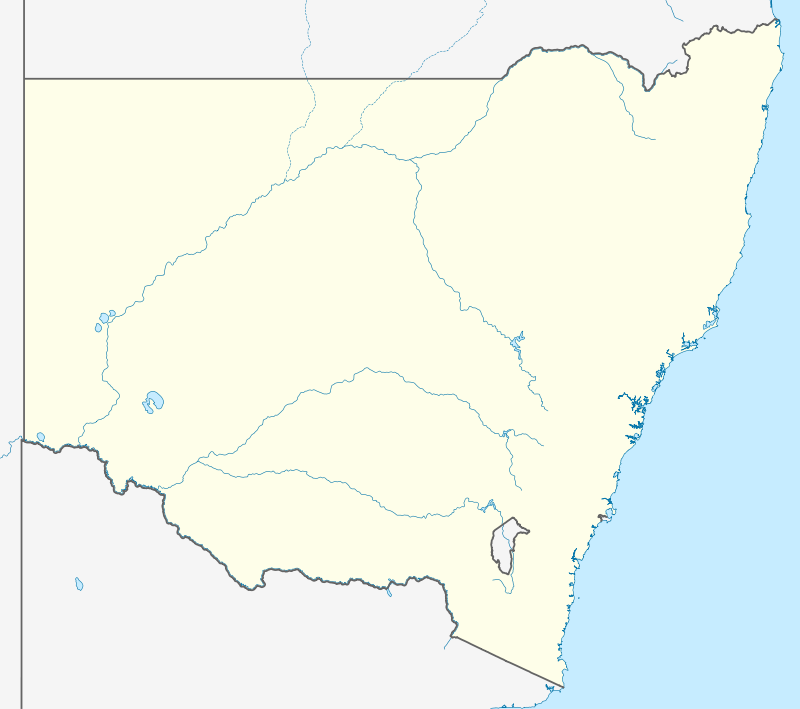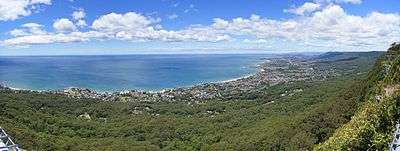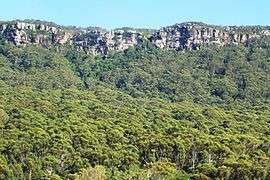Illawarra
Illawarra is a region in the Australian state of New South Wales. It is a coastal region situated immediately south of Sydney and north of the Shoalhaven or South Coast region. It encompasses the cities of Wollongong, Shellharbour and the town of Kiama.
| Illawarra New South Wales | |||||||||||||||
|---|---|---|---|---|---|---|---|---|---|---|---|---|---|---|---|
 Sunset over Lake Illawarra. | |||||||||||||||
 Illawarra | |||||||||||||||
| Coordinates | 34.5°S 150.9°E | ||||||||||||||
| Population | 311,317 | ||||||||||||||
| LGA(s) | Kiama, Shellharbour, Wollongong | ||||||||||||||
| State electorate(s) | Wollongong, Keira, Shellharbour, Heathcote, Kiama | ||||||||||||||
| Federal Division(s) | Cunningham, Whitlam, Gilmore | ||||||||||||||
| |||||||||||||||
The Illawarra region is characterised by three distinct districts: the north-central district, which is a contiguous urban sprawl centred on Lake Illawarra; the western district defined by the Illawarra escarpment, which leads up to the south-west fringe of Greater Metropolitan Sydney including the Macarthur and Southern Highlands regions; and the southern district, which is historically semi-rural (area undefined), yet now defined by increasing urbanisation.
Etymology
The word "illawarra" is derived from the Aboriginal Tharawal word "allowrie," also sometimes spelled as "elouera" or "eloura." According to A. W. Reed, the word is variously translated as "pleasant place near the sea" or "high place near the sea."[1][2] The prefix of "illa" is also known to mean "white clay;" with the suffix "warra," sometimes spelled as "wurra," meaning "mountain" in the local indigenous language.[2] George Bass and Matthew Flinders were the first Europeans to visit the area, with Flinders recording that it 'was called "Allowrie" by the natives'.[1]
For the period around 1806, the region was called "Five Islands"; referring to the group of five islands off Red Point.[1][3] In 1817 Governor Macquarie, referring to region, wrote: 'part of the coast known generally by the name of the Five Islands, but called by the natives "Illawarra".[1]
Geography



The region consists of a grassy coastal plain, narrow in the north and wider in the south, bounded by the Tasman Sea on the east and the mountainous, almost impassable Illawarra escarpment (forming the eastern edge of the Southern Highlands plateau) to the west. In the middle of the region is Lake Illawarra, a shallow lake formed when sediment built up at the entrance to a bay. The district extends from the southern hills of the Royal National Park in the north to the Shoalhaven River in the south, and contains the city of Wollongong, the fourth largest urban area in New South Wales.
North of Wollongong the plain narrows to a small strip of land between the coast and the escarpment. At Coalcliff and Stanwell Park small valleys are formed allowing further settlement. To the south it widens, and becomes increasingly hillier before reaching Stockyard Mountain, a long divide between the main plain and the Jamberoo Valley, which stretches until it reaches Kiama. South of Kiama is Saddleback Mountain and south of that the Shoalhaven plains and the outcrop of Coolangatta Mountain.
Government administration
For the purposes of Australian federal elections for the House of Representatives, the Illawarra region is contained within the electoral Divisions of Cunningham, Whitlam and the northern tip of Gilmore.[4][5][6]
For the purposes of New South Wales elections for the NSW Legislative Assembly, the Illawarra region is contained within the electoral districts of Wollongong, Kiera, Shellharbour, Heathcote, and Kiama.
For the purposes of local government administration, the Illawarra region is contained within the cities of Wollongong, Shellharbour and the Municipality of Kiama.
- The City of Wollongong forms the northernmost boundary, ranging from Helensburgh to Lake Illawarra, with northernmost coastal suburb Helensburgh and southernmost suburbs including Windang, Yallah and Haywards Bay.
- The City of Shellharbour is south of Wollongong City, and ranges from Albion Park Rail in the north, west to Macquarie Pass near the escarpment, south to Dunmore near the Minnamurra River, and bordered on the east by ocean stretching from Lake Illawarra, Warilla, Barrack Point and Shellharbour.
- The Municipality of Kiama is south of Shellharbour City, and ranges from the Minnamurra River, west to Bald Hill, and south to about 4 kilometres (2.5 mi) south of Gerroa.
Economy
The main industries in the area have traditionally been farming, coal mining and steel making. Australia's largest steel-works, BlueScope, operates at Port Kembla. The area, especially around Port Kembla and Wollongong, was once known for its mainly industrial jobs, but since the 1990s commerce has played an increasing role in the city, overtaking industry in many areas.
Illawarra cattle were originally bred in Illawarra and are now Australia's 3rd largest breed in population. They are large dark red cows sometimes with white patches. They produce large amounts of high butter fat and high protein milk and are suited to the Australian climate.[7]
Coal mining has been a key part to the Illawarra's economy for over 200 years.
Transport
The Illawarra region is linked to Sydney by several passes and a motorway (Southern Freeway) and electric railway (see Illawarra railway line); to the west by the Illawarra Highway and Picton Road; and to the south by the Princes Highway. At Albion Park Rail the Illawarra Regional Airport serves the region.
Sport
Rugby League Football
The Illawarra Steelers Rugby league Football Club played in the NSWRL rugby league competition, then the NRL, from 1982 to 1998, and currently forms one half of the St George Illawarra Dragons joint venture, who play four of their twelve home games at WIN Stadium in Wollongong. The Illawarra Steelers still field teams in the lower rugby league divisions.
Many famous footballers, such as Bob Fulton, Graeme Langlands, Mick Cronin, Rod Wishart, Paul McGregor, Craig Fitzgibbon, Luke Bailey, Steve Roach, Garry Jack, Warren Ryan, and the Stewart brothers Brett and Glenn, have come from the Illawarra region.
Basketball
The Hawks have represented the region (previously known as the Illawarra Hawks and the Wollongong Hawks) since the foundation year of the NBL, 1979. They won the NBL championship in 2001 defeating the Townsville Crocs 2-1 in the best of 3 finals. They also finished as runners-up in 2005 and 2010 seasons. The team caught global attention when American teen sensation LaMelo Ball[8] announced on ESPN's show The Jump that he will be joining the Hawks through the NBL's Next Star program. In April 2020, LaMelo Ball and his business manager, Jermaine Jackson announced they had bought the Hawks.[9]
Association football
The Wollongong Wolves participated in the now defunct NSL, winning back to back premierships in 2000 and 2001. The Wolves were not selected for the NSL's replacement, the A-League, and instead chose to compete in the New South Wales Premier League under the name Wollongong FC. The Wolves organisation collapsed in 2008, and was taken over by Wollongong Community Football Club. The Wolves have continued to play in the New South Wales Premier League.
Rugby union
The Illawarriors are a Rugby Union club that have contested the Shute Shield since 2007.
Cricket
Cricket has also been played in the Illawarra for at least one hundred and fifty years with the Keira Cricket Club being founded in 1862.
See also
- Illawarra escarpment
- Lake Illawarra
- Electoral district of Illawarra, a seat in the New South Wales Legislative Assembly
- Illawarra Coke Company
- BlueScope
- Australian Regional Rivalries
References
- Reed, A. W (1973). Place names of Australia. Sydney: Reed Books. p. 120.
- "Illawarra Range". Geographical Names Register (GNR) of NSW. Geographical Names Board of New South Wales. Retrieved 29 December 2013.

- "Northern Illawarra". NorthernIllawarra.com.au. Archived from the original on 27 February 2007. Retrieved 22 March 2007.
- "Profile of the electoral division of Cunningham (NSW)". Current federal electoral divisions. Australian Electoral Commission. 26 September 2013. Retrieved 17 December 2013.
- "Profile of the electoral division of Throsby (NSW)". Current federal electoral divisions. Australian Electoral Commission. 26 September 2013. Retrieved 17 December 2013.
- "Profile of the electoral division of Gilmore (NSW)". Current federal electoral divisions. Australian Electoral Commission. 26 September 2013. Retrieved 17 December 2013.
- "Information about Illawarra Cattle". Illawarras Australia. 2012. Archived from the original on 30 December 2013. Retrieved 29 December 2013.
- LaMelo Ball
- "LaMelo Ball buys struggling Illawarra Hawks: report". The Sydney Morning Herald. 2 April 2020. Retrieved 2 April 2020.
External links
| Wikimedia Commons has media related to Illawarra. |
- "Satellite and Aerial Video of the Illawarra and Wollongong"
- "Northern Illawarra Chamber of Commerce"